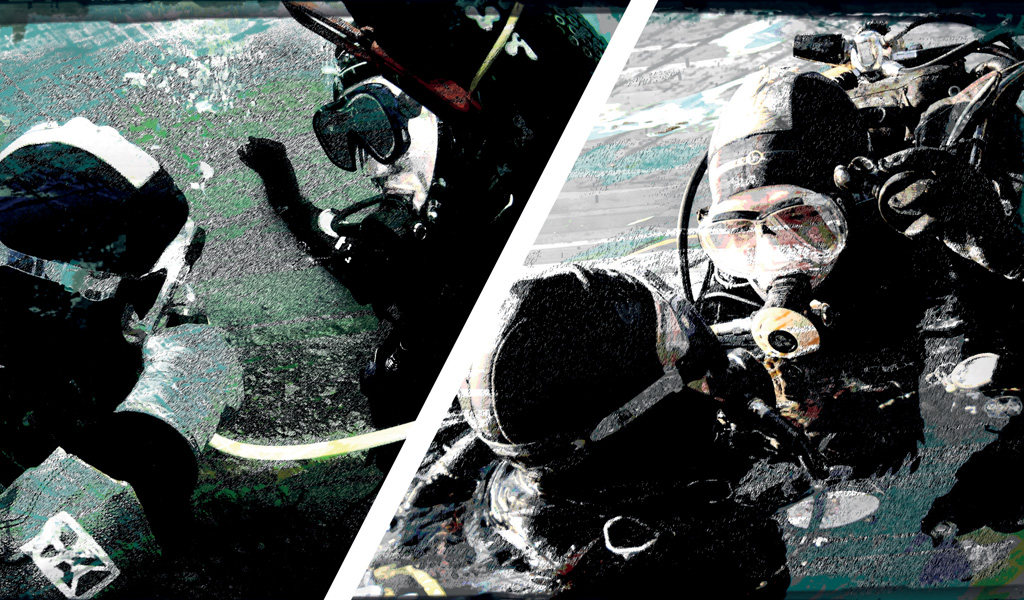
New year and an unfamiliar buddy spelled trouble for David Brown, when his new friend turned off his redundant gas supply just as it was needed.
A routine recreational dive in a quarry on a sunny day should be a fairly straightforward affair, in which the possibilities for things going wrong are slim. Leisurely floating through a submerged airplane fuselage and over a gnome garden should be about as dramatic as it gets. An out-of-air emergency was the last situation I thought I would be facing.
I am trained to Sports Diver level and I was joined by a Dive Leader friend and a newly-qualified Ocean Diver whom I had never met before. During our surface interval the dive Leader friend had to leave. I pondered whether or not to go back in for a second dive with a person I didn’t really know, but decided it would be okay. I had driven a long way and he had been completely fine in the water on the first dive; good buoyancy, no obvious quirks. On the second dive I would be the more experienced diver.
A new part of my setup was a 3-litre pony cylinder for total emergencies. During our buddy check I briefly explained that I occasionally swapped to it during dives to check it was working.
At 18 metres when swapping to the pony, my primary second stage went into free-flow – not a huge problem as I had several options for air. I put the primary second stage behind me, as the bubbles were obscuring my view and unsettling me. I made the decision to ascend using the pony bottle as my main air supply. I signalled to go up, which my buddy somehow interpreted as an instruction to turn off my cylinder! He swam around behind me and turned off – not my main tank – but the pony. He didn’t switch it back on either, just gave me the ‘okay’ signal to let me know the job was done.
My air supply was completely cut off, leaving me sucking on a dead regulator. During the buddy check I had made a mental note of the exact location of his alternate source – left-hand side by his hip. With no time to make the out-of-air signal, I immediately grabbed for it and took in gulps of precious air. My first instinct was to slow my breathing, which was very rapid and well on its way to becoming hyperventilation.
When I steadied myself, stopped kicking up silt and regained my composure and buoyancy, I took a solid grip of my buddy’s BCD and made the signal to ascend. This time it was registered properly. Halfway up he began to race a little but I instructed him to slow down. We were both coursing with adrenaline, but we were on our way to the surface and there was no longer anything to worry about. We had averted a near disaster. I have no idea what the jolly-faced gnomes made of the whole affair.
On the surface I orally inflated my BCD, as I had no air left in my cylinder. I was fully inflated in seconds, such was my eagerness not to drown. My buddy was mortified that he had nearly killed me, and couldn’t precisely account for why he’d done it either, having never been trained to undertake such an action. To his credit he stayed very calm throughout. He is now affectionately nicknamed ‘the Assassin’.
He made a bad call, but I feel, as the most experienced diver, that most of the responsibility was mine. We were a little too deep for our second dive, all my regs were set to the most sensitive settings in cold water which can lead to free-flow and I had not fully considered the myriad pony cylinder scenarios that could occur.
I guess the moral of the story is that the most innocuous situations can turn deadly if the smallest details are overlooked. Going through this has made me a better diver.
 Incident analysis by Sarah Conner
Incident analysis by Sarah Conner
A safe and enjoyable dive starts with the planning and preparation, which culminates in the pre-dive safety check. This is especially important with new buddies or new divers, and should include a signal review. In real world diving, different groups of divers sometimes have different signals – not just between different agencies but between different instructors or divers, so it does pay to review your signals with a new buddy.
Part of a buddy check is allowing you and your buddy to try out items which they might have to try out for themselves. This could involve him actually pressing your BCD’s inflator, or you grabbing and breathing his alternate air source. It’s in your own interest to know how easy it is to gain access to and breathe from your buddy’s regulator, so why be content with a cursory check where you just look a where it is stowed and nod? Its location will be more clear in your head should you need to access it under stressful conditions, and you’ll have the confidence to know you can breathe from it, as you already have.
When planning the dive, deciding what to do in emergencies should be discussed and altered based on conditions, from the weather or site conditions to the needs of your kit and buddy. This should include how long
to search in case of separation and discussing what to do in an out of air situation. It’s important to ensure that any redundant gas supply works, and this should always be done as part of the pre-dive safety check.
All too often, people miss out on opportunities to practice rescue skills because they are reluctant to sacrifice a dive to do them. I recommend checking out your regional team’s training weekends, as they should be able to support skill practice with an instructor into their timetable.
You could also join an SDC such as Lifesaving or Advanced Lifesaving which can give divers confidence with their rescue and first aid skills after practicing them with instructors to ensure they are up to certification level. They are also fun courses to join and you might meet a new buddy.
Help us to keep diving safe
You should report any diving incident in confidence to the BSAC Incident Report (All incidents used in the report are anonymous).
Sarah Conner is an Advanced Instructor and former BSAC regional coach. In addition to being an accredited HSE commercial and cave diver, she is qualified to use hypoxic trimix on open and closed circuit.
Got a similar story?
Do you have an instructive drama in which you took control of a difficult diving situation? If so, we’d love to publish your story in SCUBA magazine and online. SCUBA now pay £75 for every story published. For more details and a briefing, email the Editor Simon Rogerson.

 Author: SCUBA | Posted 15 Feb 2018
Author: SCUBA | Posted 15 Feb 2018


